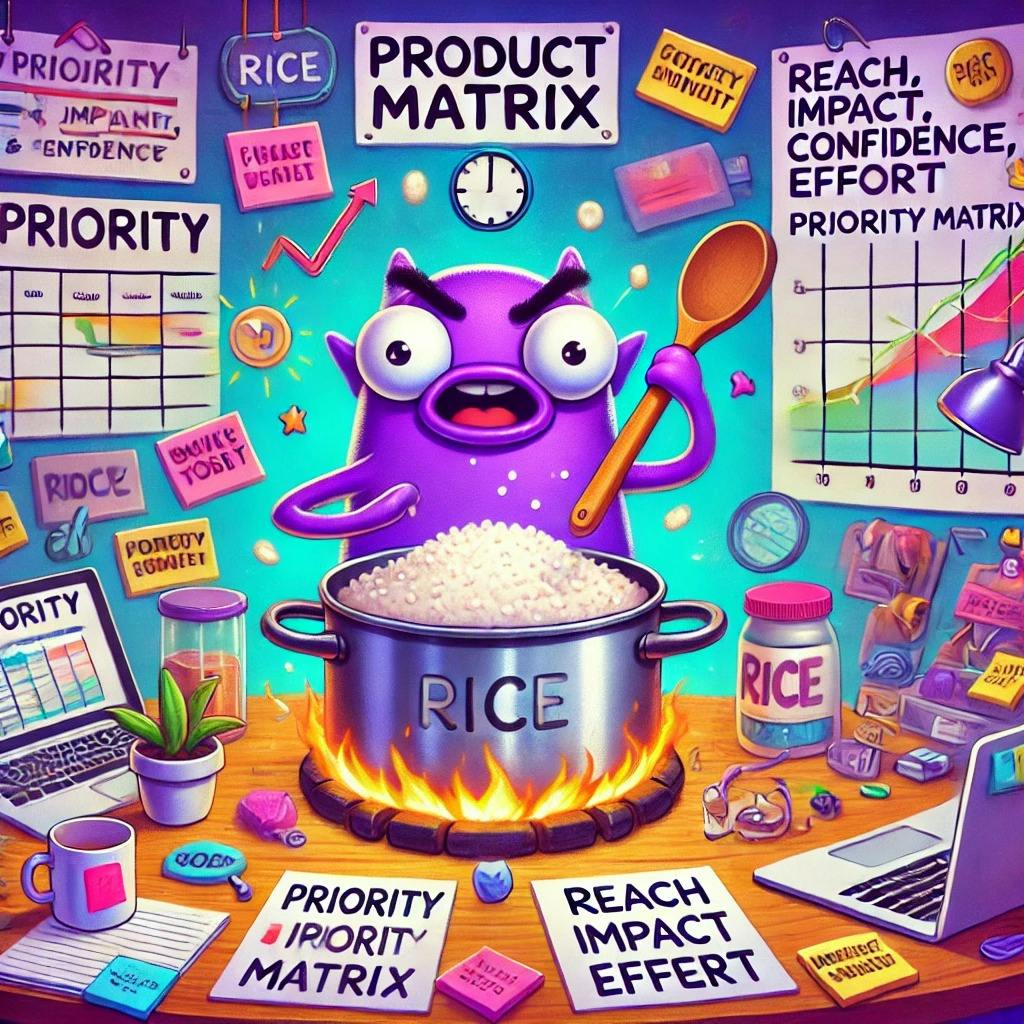Ditch your product roadmap! Here’s your all-in-one Priority Matrix. Play with it, break it, but come back for a walkthrough when you need to fix it.
TL;DR
Here, just take it, play with it, whatever.
But when you break it, come back for my in depth walkthrough on how to understand and tailor this life changing tool to your specific product management needs 😉
P.S. if you call this a “Product Prioritization Framework,” I will find you, follow you on socials, then block you. We don’t believe in frameworks, just real, actionable, how to’s.
Steal my Google Sheets template
Syllabus
Today we’re going to help you do all those things product managers say they’ll do.
We’re going to define all those buzzwords that your team smiles and nods to in your morning meetings.
We’re going to learn how to perfectly cook RICE (Reach, Impact, Confidence, Effort), and how to incorporate it into an intoxicating Google Sheets main course that will leave you feeling focused, energized, and without a hangover.
Action Item:
Copy the Priority Matrix provided and follow the walkthrough. Familiarize yourself with each column, noting how the “dumb” and “smart” columns function. Use the examples to grasp the RICE framework’s application. By the end, you’ll understand how to use this matrix to replace traditional product roadmaps and enhance your prioritization.
What’s in it for you
You’re going to walk away from this with a concrete understanding of many vague PM terms as well as a tool that will help you hit those deadlines and OKRs.
- Your founder will thank you.
- Your team will thank you.
- Your hairline will thank you.
Welcome to the only priority matrix you’ll ever need.
To be honest, This thing has replaced my product roadmap.
Sure, it’s complex, and not something to present externally, but it has become the central nervous system of our team’s product ops (and the remedy to my insanity).
Action Item:
Ditch your product roadmap—seriously, trash it (and if you have admin access to other PMs’ roadmaps, trash theirs too). This Priority Matrix is your miracle cure. As you dive in, see how it clarifies those vague PM terms you always use but can never define—I’m looking at you, “Impact.”
The secret ingredient is in between the lines of RICE
There’s 60¢ minute-rice, and then there’s your grandma’s secret recipe.
This is neither of those things.
This is 11 columns on a spreadsheet that together spell “RICE”.
That’s right. Not a lot of product teams know that RICE is actually spelled with 11 letters.
It’s more like:
RIsofmCkEdqub.
Pause here for fun definitions
Reach
The number of people or customers affected by the feature or project over a specific time period.
Impact
The potential effect the initiative will have on your goals or KPIs.
- Strategic: Alignment with long-term company goals or strategic initiatives.
- Objective: Contribution to specific, measurable objectives (e.g., Increase Daily Active Users by X).
- Financial: Direct influence on revenue, costs, or profitability.
- Market demand: How well the initiative addresses current customer needs or market trends.
Confidence
The level of certainty about the accuracy of your estimates for reach, impact, and effort.
- Key accounts: How much the change will affect your most important or largest customers.
Effort
The total amount of work required to complete the project, measured in person-months or similar.
- Dev: Engineering work required to build the feature.
- QA: Testing effort to ensure quality and functionality.
- UX: Design work required for user experience and interface.
- Business: Contributions from non-technical teams like marketing, sales, and customer support.
Action Item:
Pause and really look at the 11 columns in the matrix—this is where RICE gets its power. Go beyond the basics of Reach, Impact, Confidence, and Effort. Explore how each subcategory, from “Financial Impact” to “Key Accounts” and “QA Effort,” adds depth to your prioritization.
Understanding the priority matrix
I’ll walk you through this thing in five parts:
- Accessing the priority matrix.
- “Data Validation” tab.
- Non-formulaic “dumb” columns.
- Formulaic “smart” columns.
- The “Value” column.
Accessing the Priority Matrix
If you didn’t jump the gun and click the link in the TL;DR, then I have two things to tell you:
- I’m proud of you, kiddo.
- Here you go.
Data Validation
Go to the “Data Validation” tab.
“Status” and “Type” will not involve formulas and are not necessary to get this priority matrix to work, so you can:
- Use them as they are.
- Change them.
- Don’t use them at all.
Yeah… that’s it for the data validation tab.
Action Item:
Jump into the Priority Matrix and follow along step-by-step. Start by accessing the matrix and head to the “Data Validation” tab. Look at the “Status” and “Type” columns—no formulas here, so feel free to customize, use them as-is, or ignore them entirely. Get a sense of how these elements fit into the larger picture before diving into the more complex parts of the matrix.
Layout (non-formulaic “dumb” columns)
Go back to your first tab.
You’ll notice I froze columns A-D and rows 1-4 for our sanity.
Note: If you’re planning to omit columns, please remember to adjust the freeze view settings—for your sanity.
Now, we’ll walk through the following “dumb” columns (none of which are necessary—3/5 of which are useful).
Column A: Blank
I have a habit of keeping Column A and Row 1 blank for organizational and aesthetic purposes.
But really, it’s because it’s that last shred of my dream of one day becoming an investment banker, Excel-monkeying financial forecasts without a mouse during my 100 hour weeks in the office.
Note: For ease of following along, don’t mess with these.
Column B: Roadmap item
This is where you name your feature or project.
Column C: Value
Don’t touch this for now (It’s formulaic—the most formulaic—and therefore, the most important). We’ll save it for last.
Column D: Status
This column does not influence the value column but helps keep track of your feature’s status. This column is a drop-down that pulls from your “Status” column in your “Data Validation” tab.
My current team’s workflow is “Discovery” 👉 “Design” 👉 “To Do” 👉 “In Progress” 👉 “Staging” 👉 “Done” and “Blocked.” Feel free to adjust as needed on the “Data Validation” tab.
Column E: Type
This column also does not influence the value column but helps you identify what category of feature you’re building.
I like to classify roadmap items as “Integration,” “Platform,” “Feature,” and “UI/UX.”
You’ll also notice the color coding: orange for backend items, blue for front-end.
Adjust as needed or get rid of the column—up to you.
Column F & G: Objectives & key results (OKRs 🤢)
These two columns also do not influence the value column. I try to use OKRs.
I add them to my priority matrix to shame myself everytime I see them left blank. Let’s be honest here, no one at a startup really uses OKRs, nor has the time to deep dive into them, nor preach their importance to non-PM teammates.
But, they’re here if you want them…
Action Item:
Head back to the first tab of the matrix and notice how columns A-D and rows 1-4 are frozen. Review each “dumb” column to understand their roles. Don’t touch Column A—it’s just there for organization. In Column B, name your features or projects. Skip Column C for now; it’s the “Value” formula. Use Column D to track your feature’s status with the drop-down options from the “Data Validation” tab. Adjust Column E to categorize features as needed. If you’re feel like sucking up to your 45 year old Head of Product who hasn’t shipped a feature since the Great Recession, play around with Columns F and G for OKRs, but no pressure—they’re not essential (tell them I said that).
Layout (formulaic “smart” columns)
Now, we’ll walk through our “smart” columns.
These are necessary for the “Value” formula to work.
Column H: Approaching deadline
This is the panic button for our matrix. Throw a looming deadline on here and watch those values increase as the deadline approaches.
This adds a sense of anxiety urgency for your dev team and factors in items that are on a ticking clock.
Note: Ensure to input “Date” items the way I do: written month, day, year (or day, written month, year). Either way, you need to write out the month. This is to ensure Google Sheets doesn’t have to guess whether you are using American date format or that other format that the rest of the world uses.
Column I: Reach
This is the “R” in “RICE” (Woah, look we’re finally at something that is actually part of “RICE”).
“Reach” is the number of users affected by this line item.
If you remember from the “Data Validation” tab, reach is defined as:
- One User (1 point).
- Some Users (2 points).
- Many Users (3 points).
- All Users (4 points).
Note: Please keep these as they are. The “Value” formula is specifically looking for these inputs to allocate their associated points value.
Column J, K, L, M: Impact
The “I” in “RICE” is IMPACT! I guarantee not a single product manager knows what this means—and that’s the point.
It’s a purposefully vague term so that you can define it.
Side rant: This is honestly the craziest phenomena to me in the business world. We throw around all of these ambiguous buzz words, and have no idea how to articulate their meaning. Then, we absolutely fail to assign them a defined meaning, yet we still use them. Please, for the love of keeping product management a legitimate career path, define “Impact”—define your buzz words.
I define “Impact” for my team as follows (These are all scored 1-10, 1 being strongly misaligned, and 10 being strongly aligned:
- Strategic impact: This is our long term goal (3-5 years from now, where do we want to be).
- Objective impact: This is our short term measurable goal e.g. Will it help us reach X in Y by Z?
- Financial impact: Will it make money?
- Market demand: How badly do your customers want this?
Column N: Confidence
The “C” in “RICE” is “Confidence.” How sure are you about actually getting this thing done? How sure are you about this thing actually working? And even if it is working, how confident are you that this thing will realize the impact you estimated? This column ensures that features you’re more confident about get a little bump in priority value.
Column O: Key accounts
Does this touch any of the user experiences that affect your most important customers?
Side rant: The reason this is here is because—repeat after me—”we 👏 are 👏 realistic 👏 product 👏 managers 👏.” So many PM’s idealistically preach about being “product-led” and “productize everything.” Bull sheet—if you were a $1 Million ARR product and Google accounted for $500K of said ARR, and they asked for a feature that only benefits them, what would you do?
Exactly.
Columns P, Q, R, S: Effort
The dreaded “E” in RICE. How much work will this take?
- Dev effort: The coding grind. If it’s a small lift, it gets a higher priority. If it’s a six-month rabbit hole, maybe it takes a back seat.
- QA effort: How much effort will it take to test what your dev’s built? “QA effort” tends to have a 1 to 1 ratio with “Dev effort.”
- UX effort: Design & user experience. If it’s minimal tweaks, great! If it’s a full overhaul of the design system, well, this column is where you’d factor that in.
- Business effort: Non-techie contributions like marketing, finance, sales, support, and—yes—product management.
Action Item:
Review your “smart” columns. Column H is for deadlines—closer dates increase priority. Use Column I to rate Reach from “One User” to “All Users.” Columns J to M define “Impact”: strategic, objective, financial, market demand (score 1-10). Rate Confidence in Column N. Column O marks Key Accounts affected. Estimate “Effort” in Columns P to S for Dev, QA, UX, and Business—more effort means lower priority.
Column 2: Value
This is where all the formulaic columns on this piece of sheet come together to create your final priority value.
It’s the grand total of your RIsofmCk****Edqub calculations.
Once you’ve filled out a row, you will get a value, and once you’ve filled out your rows, you can sort by highest to lowest value.
Ta da! 🎉
Below is the formula for your reference:
=IFERROR(
(SWITCH(I5, "One User", 1, "Some Users", 2, "Many Users", 3, "All Users", 6, 0) *
(J5+K5+L5+M5) * N5 * IF(O5="yes", 1.5, 1) *
IF(ISBLANK(H5), 1,
IF(DATEDIF(TODAY(), H5, "D") >= 28, 1.5,
IF(DATEDIF(TODAY(), H5, "D") >= 21, 2,
IF(DATEDIF(TODAY(), H5, "D") >= 14, 2.5,
IF(DATEDIF(TODAY(), H5, "D") >= 7, 3, 3.5
)
)
)
))) / (P5+Q5+R5+S5),
0
)
Note: If you’re not comfortable with advanced Google Sheets formulas, I would highly recommend not touching this. Otherwise, feel free to tinker with these values until you feel like they better reflect your specific prioritization and scoring needs.
Action Item:
If you’re comfortable with Google Sheets formulas, tinker with the “Value” formula to better fit your needs. Bonus points if you add or remove columns to tailor the matrix to your product strategy. If you break it, no worries—just grab a fresh copy from the original Google Sheet. Otherwise, best to leave it as is.
Bottom line
This priority matrix isn’t just another spreadsheet; it’s your new product roadmap.
Use it, break it, tweak it—whatever you need to do to make it yours (I designed it to be tinkerable).
It’s a starting point for you to make it perfect, and it’s damn well better than another static, vague roadmap.
Now go prioritize like a pro, and may the Founders be ever in your favor.
That’s all, ya’ll.
K bye.
Steal my Google Sheets template
© James Effarah
You’ve reached the end.
























